Update: Name that baby
March 30, 2018

An update just went live on the client and the server that does several important things.
First of all, there is a new naming system. If you are Eve, you get to pick a last name (family name) that will be used by all of your future descendants. You can't pick your first name though---you're Eve. If you are a mother, you get to pick a first name for your baby.
Names are set by saying "I am _______" if you are Eve and "You are _______" if you are a mother, when you are holding your baby. You can only name your own baby, and you must be holding it.
For those of you with a mischievous twinkle in your eye, don't worry, I thought of that. The names that you pick are vetted on the server against a list of real first and last names, and the closest match is chosen if you don't pick a real name. You can check out the lists here (careful, they are huge lists):
https://raw.githubusercontent.com/jasonrohrer/OneLife/master/server/firstNames.txt
https://raw.githubusercontent.com/jasonrohrer/OneLife/master/server/lastNames.txt
And once you set a name, that's it. It never changes. So chose wisely.
The names are being logged server-side too, and I will likely do something interesting with those logs in the future, like show the name chain in the longest family line, or generate family trees, etc.
Next, a few "bouncing forever" stalled action bugs have been fixed, and a work-around has been put in place so that you'll hopefully never be stuck and die from this bug in the future (a 4-second timeout has been added to the client). Also, extra server logging has been added so that I can catch and fix the remaining cause of this bug.
And one invisible-self-as-baby bug was fixed. There are still likely some invisible-person bugs lingering, however.
| Fan Art
March 27, 2018

| RAM-based map caching to reduce server CPU usage
March 27, 2018
Summary: It worked.

Profiling has long shown that map reads consume the majority of CPU resources on the server, especially in areas of the map that have a lot of full containers (each container acts as a multiplier on the amount of information that needs to be fetched for a given tile). As people walk around the map, they look at big chunks of the map all at once, and this produces dramatically more load than map writes (which only happen when a player does something). A player usually changes (writes) about one tile per second on average, but as they walk around, they might be looking at hundreds of tiles every few seconds.
I added a hash table for caching recently-read tiles from the map to make reads much less expensive. Since writes are way less frequent, they can still be expensive: changed tiles are both written to the hash table and instantly pushed into the disk-based database. Thus, the map on the disk never lags behind reality.
Additional profiling also found a few more places where I could squeeze out a few redundancies. For example, substantial load was coming from checking whether each item in a container had decayed. But most things in most containers currently don't decay at all. Might as well remember whether a container holds any decaying items or not, so we don't have to keep checking every item every time we look at the container.
The impact on CPU load can be seen above, with the whole graph representing 40 concurrent players on a cluttered map.
| Launching a game Off-Steam: Sales number from Week 1
March 9, 2018
I've heard it many times, from both friends and strangers alike (and even a bit from my spouse): "Jason, don't you think you're nuts for not releasing this game on Steam?" Steam has changed a lot over the years, though.
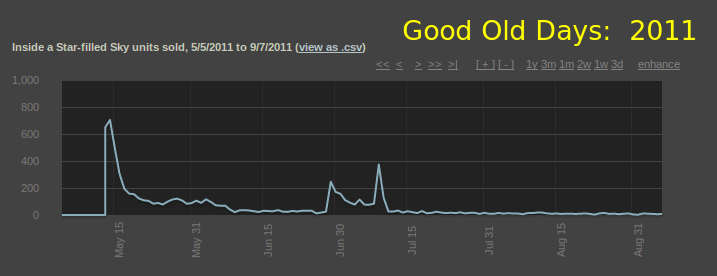
Back in 2011 when my game Inside a Star-filled Sky launched on Steam, Valve worked with me directly to pick a release date that had no major conflicts. My game was the only game that came out that day on Steam. I'll repeat that for emphasis: my game was the only game that came out that day on Steam. It remained on the new release list for almost an entire week, sitting there on the front page of Steam for everyone to see. That exposure helped this otherwise-unknown game sell 649 units on the first day and 704 on the second day, and achieve a peak of 43 simultaneous players on day two. For me, at the time, those sales number were huge and career changing. Of course, the normal drop-off and long tail followed, with occasional spikes during the sales that I participated in. But the biggest influx of players and revenue came during launch.
Fast-forward almost seven years. On Tuesday, February 27, 2018, I counted 83 games launching on Steam that day, the same day that I launched One Hour One Life off Steam.
Steam still has a lot to offer: a huge install-base of dedicated players, a channel for games to spread virally (because you see what your Steam friends are currently playing), and a top-notch player-submitted review system. And of course, some players "just don't buy games that aren't on Steam."
Some people even claim that no game released off-Steam could ever be successful. Such games, it would seem, are doomed to failure.
However, we have to keep in mind that the very most successful games of all time on PC have never been on Steam and will never be on Steam: Minecraft, League of Legends, Overwatch, and Hearthstone.
Minecraft is a great example: the order form, as I originally encountered it back in the day, was worded in Swedish, and the price was only listed in Euros. The point is, if a game is good enough and attractive enough, players will overcome their hang-ups and find a way to buy it, even if it's not on Steam. My goal is to make a game that's so good that it won't matter. Shouldn't I be trying to make a game that is just that good?
Finally, I certainly might have doubled or even tripled my first-week sales numbers if I had launched on Steam. But, as a solo developer, I'm barely able to keep up with the demand and influx of players as it is. I'm doing personal tech support and community management. There were a few show-stopping bugs on certain platforms that I didn't catch before launch. The servers are already half-full, and it will be time to get more up and running soon. This kind of game---a super-complicated multi-server, multi-platform, multiplayer game---pretty much requires a slow roll-out.
Another big difference is the nature of the "games press" these days compared to seven years ago. Back then, every news and review outlet covered Inside a Star-filled Sky at launch. I had an even bigger press response to The Castle Doctrine a few years later.
But in the mean time, the game press essentially vanished. Some websites don't exist anymore. Others are helmed by skeleton crews. Still others have shifted focus and pretty much don't talk about new games anymore.
Thus, to get the word out about my launch, I was really depending on Twitter and my 19K-member mailing list. However, email, as you're probably aware, is riddled with delivery issues. I'm paying for services that supposedly ensure inbox delivery, but they don't work very well.
All these factors conspired to make my launch numbers pretty sad:
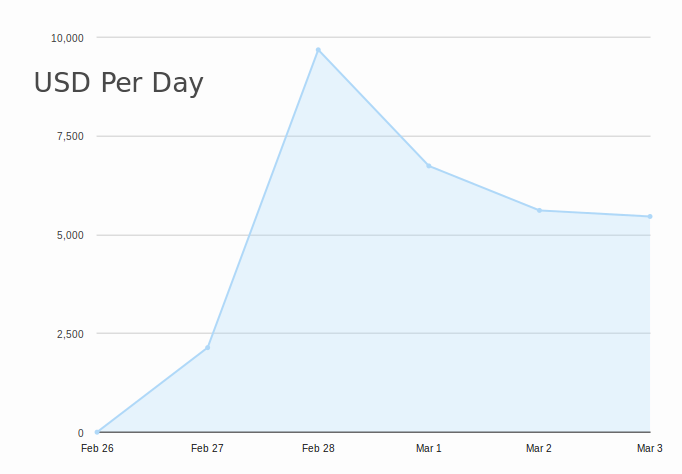
Oh crap, look at that! The exponential decay curve was already kicking in just a few days in. Was it all down-hill from here? If so, the future of the game was bleak, because the top of the hill wasn't very high at all, relatively speaking. 484 units.
But if the games press isn't relevant anymore, how do people find out about new games? There are two ways: word of mouth, and YouTube videos. Word of mouth has always been the most important factor for any game, I think. When your friends keep playing a game and keep talking to you about it week after week, you are much more likely to buy the game yourself.
YouTube is a comparatively new factor, but it's a bit like crowd-sourced word of mouth, and also a form of try-before-you-buy. You watch someone else kick the tires so that you know what you're getting into.
But here's the thing: some games are way better at generating word of mouth and YouTube videos than others.
What kind of game generates the most word of mouth? A game that players tend to play long-term, week after week, month after month. Your friend will talk about it this week, and next week, and the week after that. Your friend will just not shut up about this game.
If your friend is still playing months later, it's likely that the game is somehow generating an endless supply of unique and interesting emergent situations. And guess what? That kind of game also makes for great videos. Each video can show people something from the game that they've never seen before.
A game that doesn't have these properties depends on buzz at launch to sell. It also depends on the critical mass that Steam can bring, to give it a chance to go viral during the brief window that people are collectively playing it.
But the press is gone, so buzz is much harder to generate, and Steam is crowded, so going viral there is much more uncertain.
The new world of video game success seems to be happening mostly outside the game press and independently from the impact of Steam's crowded new release list.
I designed One Hour One Life intentionally to operate well in this new paradigm. It is, hopefully, a unique-situation-generator, down to its core, and it's endlessly replayable. It also generates unique situations at a kind of meta level, because civilization collectively advances even when you're not playing. If you make another video next week, it will show something quite different from the video that you made last week.
But these things take time to cook and build. Word of mouth isn't instantaneous. YouTube videos take time to make. To my shock and happy surprise, the downward trend started reversing a few days after launch:
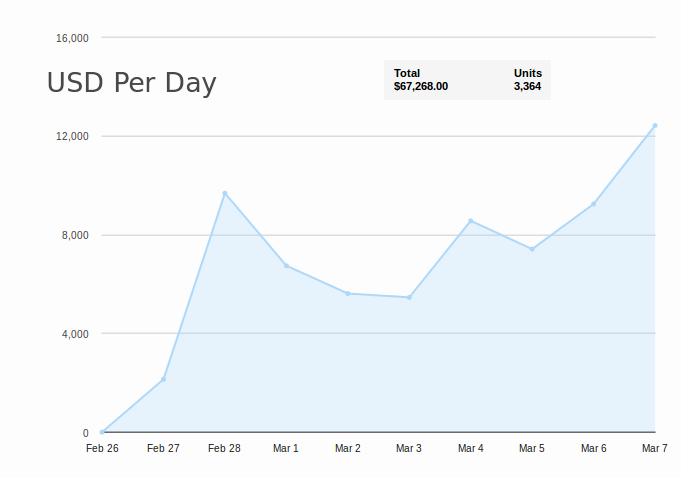
Until finally, today, I had my best sales day ever, by a large margin, a full week after launch.
The Castle Doctrine was a pretty huge hit for me, relatively speaking. It generated a lot of press buzz and word of mouth, and it managed to bring in something like $70,000 in the 11 months that I sold the alpha through my own website, before launching on Steam. But yeah, that was over eleven months.
I realized today that in just over a week, One Hour One Life has brought in nearly as much as what The Castle Doctrine brought in over 44 weeks. And The Castle Doctrine's graphs, both on and off Steam, always had the classic exponential fall-off after the launch spike.
So what's happening here?
Well, YouTube has been a huge factor, as several 100K+ view videos started getting posted a few days after launch. The comments on these videos are telling, with many people begging the YouTuber to make more videos about the game. And some of those YouTubers have. Some are on their third video at this point, with each video thrusting them into new and interesting situations.
But the other factor is that the players who started playing the game around launch are still playing the game and talking about it a week later. They are not "finished' with the game. They haven't moved on.
I'm getting ready to put out the second of my weekly content updates since launch, but even without my input, the game world is changing as civilization advances, making it worth coming back to. Thus, the critical mass of hourly active players is growing:
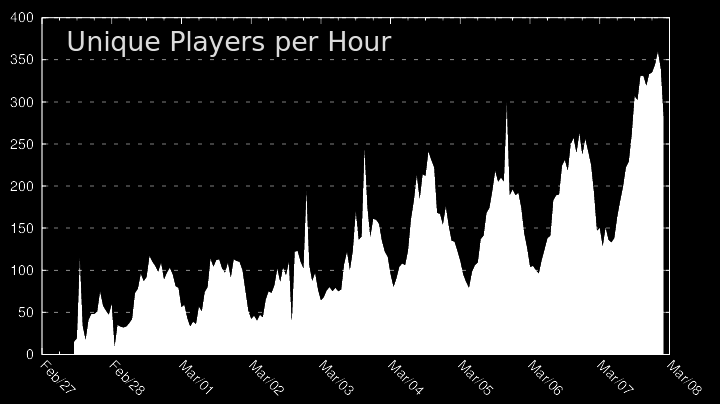
Given that I've been working on this game for three years already and have at least two more years of work to go, the revenue generated by this game during launch week has not come at all close to making it a financial success. However, it does look like it might be operating in a new paradigm of public interest in games, which is a slow build up to steady growth over the long haul.
| Everything runs out
July 26, 2017
A friend of mine summed up a design theory for this game as "evolve or die."
Essentially, there should be no steady state, where you finally break free from the survival struggle and can be fat, dumb, and happy for the rest of your life. The garden of Eden can never be returned to. No living off the fat of the land. The land is too thin for that.
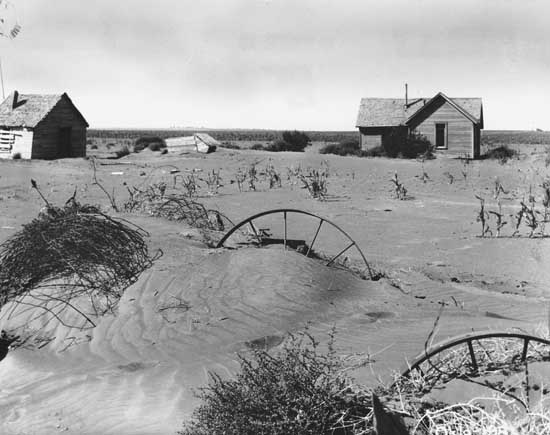
On a larger scale, the same is true for a village. Maybe it can start to feel like a steady state for a few generations, but in reality, those generations are making a grave mistake by living that way. If they're not developing the next level of survival technology, they are dooming their village in the future.
The graph of progress should look like saw teeth, with catastrophes every so often when we realize that what we thought we figured out isn't working long-term.
As I was playtesting yesterday, testing some server fixes, I was noticing how infinite anything makes that particular thing robotic and uninteresting. I don't need to care about it or think about it or consider it or spend it wisely. I just go to the known spot and get more of it, as needed. I was keeping a fire going, and like a robot, every so often I'd walk back to the branchy trees, pick a new branch (respawn time for branches is something like 60 seconds, and yew branches are infinite), chop it into kindling, and feed my fire. It was tedious. The computer might as well have done this action for me, each time my fire ran out. I never had to make a decision. Should I use this wood for fuel?
So.... what if each tree only has one branch to give? Each yew tree only one yew branch? What if the clay node only gives 4 clay before running out? What if the fertile soil node only gives 4 tilled rows before running out? What if each tule reed patch can only be harvested once? What if the ponds run dry (and geese leave) after enough water trips? What if rabbits don't respawn after snaring?
As Eve, you are literally plopped down in Eden, with all of these wild resources in their best possible, full state. Every tree has a dead branch waiting. Fertile soil nodes just brimming. Berry bushes full.
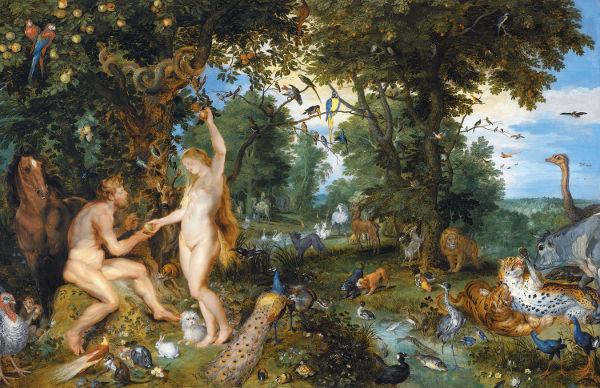
It could even "feel" easy at first, but that feeling is an illusion. You won't make it past age 30 unless you kick it into gear and carefully shepherd these actually-limited resources toward better survival tech before they run out.
And, this pattern should continue, all the way up the tech tree. You are planting berries and carrots, which helps you survive when the wild bushes and rabbits run out, but eventually you run out of water. You are developing the steel ax to harvest more firewood and building wood after the branches run out, but you eventually run out of trees. You develop a pump to pull water out of the ground, but eventually you run out of fuel for the pump. You are developing fertilizer that lets you make your own fertile soil, but eventually you run out of the base ingredients for the fertilizer.
It seems like all of this engenders difficult decisions every step of the way. If I have a bit of grain, do I plant more wheat with it, feed it to my horse so I can travel distances, or feed it to my cows so they produce milk? If I have a bit of fuel, do I put it in the plow to till some rows, put it in the pump to get some more water, or put it in the mill to grind some grain into usable flour?
One question that arises: when I say, "run out," do I really mean it? I'm not sure. Like, if one population strips the wild world bare in some radius, and then time passes before a new Eve, she could actually be stuck with no means to re-bootstrap if nothing comes back, ever. If branches and berries are permanently exhaustible, there's no starting over, for anyone, without moving elsewhere. And wandering around looking for greener pastures isn't very interesting. Salvaging progress from the last failed civilization is much more interesting.
So, I'm currently thinking that everything is "lifetime exhaustible." As far as a player is concerned, each tree only gives a branch once. Each berry bush can be emptied once. But they replentish every hour, so the next Eve has a chance. Wild stuff is always there, slowly building in the background, as a possibility if needed, but it can't be depended on for more than a short bootstrapping phase. After you've got a farm or whatever, a trip out into the forest to pick berries can still happen from time to time.
But some things are perma-exhaustible. Like if you chop down a tree and don't plant a new one, that's it. If you dig a wild carrot up, that's it. And a few trivial things, like tinder and leaves, are still infinite, because it would feel too weird to make them limited.
I do worry that this encourages an Eve strategy of "quit playing and come back in an hour." Like if the wilderness feels too lean, or you mess up too much, waiting an hour will bring it all back and give you a new start.
I could also refresh everything on each new Eve, but again, that seems to make Eve suicide a viable strategy.
If it refreshes on Eve, but only if she's different than the last Eve, then it encourages multiple accounts.
The only way around this seems to be to make everything perma-exhaustible. There's no timing trick that you can use to work around it. If you, or the person before you, exhausted the wild resources, your only choice is to find greener pastures to re-bootstrap. You can find you way back to the old city later.
This reminds me of the book Ishmael. There's an analogy in there about civilizations being like flying contraptions, and it's easy to confuse falling with flying for a while, when we jump off the cliff with our flapping wing suit or whatever. The ground seems to be getting closer, so we flap the wings harder. We look down on the ground below and see an array of other crashed flying contraptions. Why did they crash? We'll never know. But we're not going to crash like them! We have it figured out.
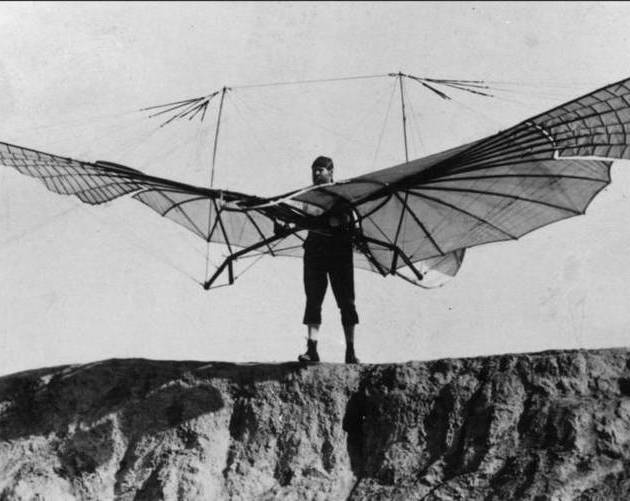
Like every time we find the ruins of an abandoned civilization, we scratch our heads. Why would they ever leave all of THIS? Well, we're never leaving ours, that's for sure.

Just to prevent the map from forever expanding into greener pastures, maybe wild resources could respawn on some kind of glacial time scale.... like every 24 hours, or every week, or something.
|
|
|